#black leafcutter bees
Text
Black Bees and Yellow Sumac: A Wonderful Fall Combination
Black Bees and Yellow Sumac:A Wonderful Fall Combination shows readers some photos of a carpenter mimic leafcutter bee as it feeds on winged sumac flowers. It goes on the explain how the bees were named and discusses the author/artist’s experiences.
Black Beauty
The winged sumac flowers have come and gone, but they’re not forgotten. Back in September, when they were blooming like crazy, the pollinators were flocking to them. It definitely made for a couple of fun photo sessions out in the woods and also some great color combinations. There’s just something about hundreds of little yellow flowers that looks really stunning with black or…

View On WordPress
#bee photographs#bee photography#bees#black bees#black insects#black leafcutter bees#carpenter mimic leafcutter bees#fall bees#fall insects#Florida bees#Florida insects#Florida leafcutter bees#insect photographs#insect photography#insects#leafcutter bee photographs#leafcutter bees#macro photographs#macro photography#photography
1 note
·
View note
Text

a fun wasp for your appreciation: this is Leucospis affinis. like some other chalcidoids, she’s got thick “thighs,” although she’s a giant compared to the tiny parasitoids she’s related to, at about the size of a yellowjacket wasp (a little smaller, really).

Leucospis has a very long ovipositor that rests curved over her back. when she finds a suitable piece of wood that has a leafcutter bee nest in it, she seemingly splits her abdomen in half, unsheathing the wire-like inner portion of the ovipositor that she uses to drill through the wood to reach her target.

a cute face!
unusually for chalcidoids, her wings are furled when at rest and stick out at angles, rather than lying flat on her back. this, plus her large size and black-yellow-maroon color scheme, makes her an almost perfect mimic of local potter wasps—a good thing to be disguised as, since while she cannot sting with her ovipositor, potter wasps definitely can.


her mimicry was so good that I thought I was looking at two Euodynerus hidalgo boreoorientalis nectaring on this boneset. the second one is the real thing, though—no crazy ovipositor or beefy thighs!
349 notes
·
View notes
Text
Uncharismatic Fact of the Day
Just because bees and wasps can look alike, that doesn't mean they're friends. In fact, many types of wasps will gladly parasitise their black and yellow counterparts; for example, chalcid wasps will sneak into the nests of mason and leafcutter bees to lay up to 50 inside a developing bee larva, which then becomes food for the new hatchlings!

(Image: A female Brachymeria femorata by Bogdan Wiśniowski)
If you like what I do, consider leaving a tip or buying me a ko-fi!
52 notes
·
View notes
Text




















Zuzu's Bug-ventures: Jersey Shore Edition!
Halfway through my vacay at the Jersey Shore and figured I should post everyone I've seen so far. A good amount of these are common af flies, but I decided to include them anyway.
Restless bush cricket (Hapithus agitator). It sure is restless and an agitator. They scream all night and all morning, but are impossible to see. I'm actually surprised one jumped up onto the boardwalk for me
A type of orbweaver spider (Neoscona crucifera). Orbweavers are really common here, I've seen half a dozen of them already
A species of midge (Glyptotendipes barbipes).
Lesser house fly (Fannia canicularis). Just a fly
Housefly (Musca domestica). Just a fly, but apparently more important than the other guy
Buckeye butterfly (Junonia coenia). Had to zoom in pretty far to get this one, but it's really cool! I was like "damn, what if I found something rare!" Turns out they're common af. Still has spooky markings though!
Tan jumping spider (Platycryptus undatus). Doesn't get any cuter than this little friend blending into the boardwalk.
Starbellied orbweaver spider (acanthepeira stellata). Orbweaver: Spiky Edition!
Unsure of ID. Possibly Anaspis frontalis, though those might not not be in North America??? I'm stumped on this one
Black firefly (Lucidota atra). I don't think I've seen a single lit up firefly this summer :(
Common green bottle fly (Lucilia sericata). Just a fly, but green. And common.
White-jawed jumping spider (Hentzia mitrata). Had to zoom in. Found this guy by inspecting some leaves.
Unsure of ID. Possibly a corn earworm moth (Helicoverpa zea). It was sitting perfectly on a car, then as I got out my phone it decided it gotta go fast.
Fruit fly (Drosophila melanogaster). Just a fly, but of the fruit-loving variety. Been finding them all over the kitchen, including dead in a drop of olive oil and dead inside a blender filled with dish soap. Can't control these mfers
Yellow dung fly (Scathophaga stercoraria). It's getting old at this point. I've now seen every common fly in existence.
Fiery skipper butterfly (Hylephila phyleus). A skipper! Stood still! Just for me!!!!
Drain fly (clogmia albipunctata). As gross as they are and as much as they remind me of the dormitory showers at college, I've always liked the heart shape.
Unsure of ID, probably a wolf spider (Alopecosa kochi). Saw this completely by chance. I was checking out an empty web and happened to see this fellow chillin nearby. Wolf spiders don't make webs, so it was a fun surprise!
Unsure of ID. Someone on reddit suggested it's a spittlebug. It seemed much rounder than that, but it's the closest I've come to an ID. It was REALLY small-- found it on my shirt and zoomed in incredibly close
Unsure of ID, possibly a leafcutter bee (Family- Megachilidae).
So that's it for now! I'm here until next Tuesday, so we'll see if anything cool (that isn't a fly) shows up. I've been chasing a huge yellow butterfly all over town, but it never seems to land.
#Zuzu's bug ventures#insects#tw insects#bugs#tw spiders#spiders#insect identification#spider identification
6 notes
·
View notes
Text
Anthro Allies Remastered (Part 10)




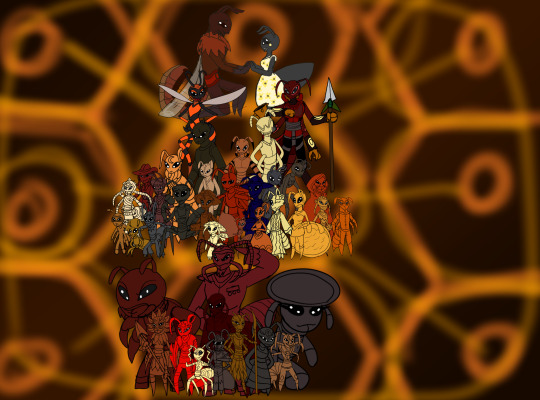




Now the Third and Final Part of the Arthropods
Endoterygota
Emorrossa (Insect Queen)
Lord Hexagath (Insect King)
Sawfly
Buzza (Sawfly)
Team
Stem sawfly
Horntail
Cedar wood wasp
Webbed Leaf
Xyelid
Megalodontes
Parasitic Wasps
Crimson the Abominable (Thistledown velvet ant)
The Hoard
P. Wood wasp
Sirex Woodwasp
Ichneumon Wasp
Gall wasp
Chalcid Wasp
Fairy wasp
Ensign Wasp
Crowned Wasp
Cuckoo wasp (Emerald wasp)
Velvet Ant (Cow killer)
Spider Wasp (Tarantula Hawk)
Tiphiid wasp
Scoliid wasp
Mammoth Wasp
Cockroach wasp (Jewel Wasp)
Sand digger wasp
Cicada Killers
Ant hunter wasp
Bee wolf
Aphid wasp
Eusocial Wasp
Queen Assaut
King Vespa
Prince Axe
Princess Strike
Warriors
Hornets
Yellow jackets
European wasps
Paper Wasps
Executioner wasps
Warrior wasps
Potter wasps
Hover wasps
Pollen wasps
Honey Wasp
Ants
Queen Amber
King Ore
Prince Beryl
Princess Siafu
Special Forces
Acrobat Ant, Dracula Ant, Exploding Ant, Mafia Ant, Shining Guest Ant, Sugar Ant
Colony
Black Ants (Garden worker), Red Ants (forager worker)
Argentine Ants (Warrior), Erratic Ants (sun workers), Needle Ant (Warrior), Ghost Ant (Scout), Stink Ants (aphid and caterpillar farmer), cone ant (pest control)
Eciton Ants (Generals/Tanks), Driver Ants (Army)
Trap Jaw Ants (Trappers), Dinosaur Ants (Moon Worshippers)
Diving Ant (Swimmer), Honey Pot Ants (Food dealers), Crazy Ants (Wild cards), Amazon Ants (Raider), Carpenter Ants (Builders), Tree Ants (Warriors), Hodor Ant (Bouncer), Giant forest ants (gladiators)
Leaf Cutter Ants (Builders), Weaver Ants (handmaidens and caretakers), Lemon Ants (mushroom growers), Pharaoh Ants (communication), Harvester Ants (harvesters), Pirate Ants (rogues), Raider Ants (raider), Electric ants (warriors), Fire Ants (Warriors), Big headed ants (Guard)
Bees
Queen Apidae
King Apo
Prince Kyle
Princess Pollen
Bee Hive
Dwarf/Asian Honey bee, Giant/European Honey Bee, Dog Bee, Sugar Bag bee (Honey makers), Carpenter bee (Builders), Bumblebee (Nectar collector), orchid bee (Flower manager), Sweat Bee (workers), Long horned Bees (Workers), Digger Bees (nest builders), Mining Bees (Mining and Excavation)
Plasterer bee (builder), Polyester bee (cloth maker)
Carder bee (Collectors), Leafcutter bee( (Weaver), Mason bee (molder), Wallace giant Bee (blacksmith)
Pantaloon Bee (Guards)
Australian Bee (soldiers)
Daniel and Lyon (lacewing & antlion)
Xan (Snakefly)
Zip(Alderfly)
Grounder (Ground beetles)
Live wire (Telephone pole beetle)
Knock Knock (Deathwatch beetle)
Lucky (Ladybug)
Lumi-Nate (Firefly)
Adorn (Jewel beetle)
IronShell/Ira (Horned Scarab beetle)
Horns (Stag Beetle)
George Schmutz (Dung beetle)
Red Rover (Rove beetle)
Ballin (Boll weevil)
Waxer (Giraffe Weevil)
Twist (Stylops)
Twiddle (Stylops)
Harleigh (Butterfly/Moth)
Eugene (Monarch Butterfly)
Genevieve (Silk Moth)
Cassidy (Caddisfly)
Bethany (House/Horse Fly)
Pesky (Gnat/Midge)
Zika (Mosquito)
Rome (Hover/Robber/Crane fly)
Sting (Scorpionflies)
Ichor (Fleas)
Previous/Next
(For More Information About The Earthdemons, Neo demons, The Anthro allies , the O'Kong family and more of theses characters as well as updates please visit the @the-earthdemon-hub for more)
#my art#my ocs#elementalgod aj#aj the elementalgod#isle 0#Toonverse ocs#The Watchful Eye#Watchful Eye#O'Kong Family#Earthdemons#Neo Demons#Anthro Allies#hexapoda#insects
6 notes
·
View notes
Text
i wanna just deep dive on my plants for the moment:
Plot 2
Thai eggplant- still recovering from the flea beetle infestation. it seems to be getting a little better with new leaves forming.
Purple Basil- all but the smallest are growing big, bushy, and starting to flower.
Habanero Peppers- still seem a bit small, but flowering, even though some are quite tiny. The leaf cutter bees are still going at them.
Chili de árbol- doing ok. all the bottom leaves are gone, but still going fairly strong. the leaves always seem wrinkled, even though it gets the most water.
Thai eggplant- doing better. still gets droopy in the sunshine. small new leaves are forming, but they look like they're already browning.
Carrots- doing quite well. The one furthest to the back could probably be pulled.
Buttercup squash- doing great. i have at least 3 squashes growing and lots of flowers.
Stevia- big and bushy. it bends towards the barriers and I kinda want to fill in that small space with the ones I'm currently propagating.
Chinese Long beans- doing really well. i wish I had the poles set up better because they're a bit crazy and hard to get around in search of beans. by the time I find them, they're ready to go to seed.
Black Diamond watermelon - going crazy, going ham. i have 2 vines with quite a few flowers already. the 2 nasturtiums I threw in there are also growing.
Yellow squash- so many flowers. so far I've only male, but they're doing amazing.
Strawberries- even the the leaves are dying, more are coming in. soil is ready for the new plants once they come in.
Plot 1
Baby Bush watermelon- 2 out of the 3 are finally starting to grow. only one nasturtium is growing (I thought 2, but it was a stick.)
Green squash- trying to catch up to the yellow squash. 2 sets of secondary leaves and it looks like flowers want to form.
Sweet Basil- just ok. looks like something is eating at them a little.
Tomatoes- much better. they look like they're ready to go another round, as they're currently flowering. the 3 in the back are still stagnant and one is actually doing pretty bad and starting to brown rather than mature.
Holy Basil- doing quite well. maturing and losing the older damaged leaves.
Peppers- The leaves are being ravaged by the leafcutter bees. some flowers are forming, but nothing is vei g pollinated. no new serrano sprouts as of yet. the cherry hot peppers are doing well and maturing quite rapidly.
Thai basil- back from the dead and doing well. basil is truly resilient, i swear. i just got to get it past the seedling stage, it seems.
Kabocha/ Honeydew Melon- doing great. the Kabocha looks to have 2 fruits growing. nothing for the honeydew, but it's vining like crazy.
Cucumbers- doing better. quite a bit of new leaf growth on the vines and some flowering. i think planting a few more was a good idea as i don't have many more cucumbers currently growing. i do need to do a good pruning on the vines, though.
0 notes
Photo

Leafcutter bee. Knowledge. v.21. April 1, 1898.
Internet Archive
142 notes
·
View notes
Photo

I like looking at this shot, the symmetry, this alien being, this unknowable insect, there is something alive, even relatable here.
This one is worth looking at full-screen.
What if, indeed, this Megachile brevis, was as large as a puppy dog, would we treat it the same as we do now?
A bug can be ignored, because it doesn't sting us and because it isn't the size that our eyes can view all the particulars, all the wonderful details that are built into this being in a similar but different way than the flowers that pollinate's and we honor by making him into bouquets and making them integral to all our major life events.
Would they make good pets? Would they like to be groomed by us, scratched behind the head? My my I probably shouldn't write these things late at night they're just too many rabbit holes out there to fall into.
All original pictures completely public domain and available at our Flickr site: https://www.flickr.com/photos/usgsbiml/
Photography Information: http://www.youtube.com/watch?v=S-_yvIsucOY
Follow us on Instagram: https://www.instagram.com/usgsbiml/
Download our free field guide to the genera of bees:
http://bio2.elmira.edu/fieldbio/beesofmarylandbookversion1.pdf
Public Bee Servant, sam droege
#bee#bees#bug#bugs#leafcutter#megachile#fade#black background#green eyes#naturalist#natural#flying#flight#fuzzy#usgs#bee lady
189 notes
·
View notes
Photo

Female Black and White Leafcutter Bee being bitey.
(photo by S Suzuki-Martinez)
3 notes
·
View notes
Text
August 2022: The Last Tuesday
Curbside find - two T-posts & two U-posts:

Leafcutter bee snipping a little watermelon leaf:

Today’s backyard garden harvest:

What’s on the menu for the birds this week - black oil sunflowers & dried mealworms. I buy the seeds & mealworms separately & blend them myself:


My queen ordered some Scotch Bonnet peppers from Humble Servants Homestead’s Etsy store:

#curbside find#u-posts#t-posts#watermelon plant#leafcutter bee#backyard garden#garden#pole beans#purplehull peas#bird seed#sky#blue sky#clouds#mourning dove#golden jasmine#scotch bonnet peppers#humble servants homestead#life in memphis
5 notes
·
View notes
Photo


It’s bee week here on Celestial Macros, just because I photographed 10 different species of bees on Saturday (And none of them were honey bees or bumble bees.)
Carpenter-mimic leafcutter bees, male (fuzzier) and female (all black) (Megachile xylocopoides)
July 31 and August 1, 2020
Southeastern Pennsylvania
A southeastern U.S. species seen at the northern edge its range
1st of 5
#first Pennsylvania record on BugGuide#bee#bees#photographers on tumblr#Megachile xylocopoides#leafcutter bees#carpenter mimic#bug#bugs#bugblr#beeblr#entomology#hymenoptera
175 notes
·
View notes
Text
The Work of Bees Last Fall Leads to Beautiful Flowers Now
The Work of Bees Last Fall Leads to Beautiful Flowers Now discusses the role of last year pollinators in helping to bring us crops and wildflowers this year. It shows readers one of the many types of bees found in Florida.
Eager Bee
Last fall before the first frost, the area was crazy alive with bees. There were many different types of them stocking up on nectar and pollen to get them or their hive or nest through the winter. There were lots of flowers, especially blackjacks, that time of year. This was one of many bees that were buzzing around from flower to flower not only eating, but also carrying pollen…

View On WordPress
#beautiful bees#beautiful insects#bee photographs#bee photography#bees#black bees#black insects#carpenter-mimic leaf-cutter bees#Florida bees#Florida insects#Florida pollinators#insect photographs#insect photography#insects#large bees#leafcutter bees#photography#pollinators#solitary bees
2 notes
·
View notes
Text
OC Bios!
Name: Jayson Knudsen (HL variant)
Age: 25
Pronouns: He/Him
Species: Human
Gender: Male
General Info: Survivor from the Seven Hour War, Jayson was sent to City 17 alone by boat at a young age to carry on his family for future generations. Twenty years later, he cut his hair, changed his name, and lives in the sewers hiding from being Combine that would push anyone around. To make it through life, he steals supply crates from the train station and gives out the ammo, rations, and clothes to civilians who need it and Black Mesa East's rebels. He's only tied to the rebellion by shipping supplies out on his own, dling every bit he can to help end this Combine reign.
Height: 5'5"
Media: Half Life 2
Name: Yunqi
Age: 23
Pronouns: He/They/She
Species: Human/Lego Human??
Gender: Fluid
General Info: A young adult working in an antique/relic shop in Megapolis can only give you so much entertainment. That is until he's found himself running into demons and finding a demon library with a book on protection spells, wards, and other magic in old languages. Now they spend their time running shop while also studying magic as a mortal! Given training by a demon of the wind, Yunqi has become more stronger and less cowardly than before, but of course all that comes at a price. Having to fight for the city and help save it years before the Monkie Kid rises. Did I also mention they found a relic that stops them from aging? It gives off a strong magic aura that gives him away and must protect from other demons.
Height: 5'4"
Media: Lego Monkie Kid
Name: Clover
Age: 17
Pronouns: She/Her
Species: Red Panda (Mobian)
Gender: Female
General Info: A cutesy red panda with a tail that can be used like a mace! While fluffy, getting hit with the end of the tail can knock someone back pretty far! Downside is that it can mess with her balance a bit, having the tail be heavier than it should. Clover is just the average Mobian that aspires to be a Freedom Fighter, but she's leaning more towards doing her own thing. Even had a few run ins with Team Hooligans. Possible rivals??
Height: 5'2"
Media: Sonic the Hedgehod
Name: Cypress Man
Age: Teen-Young Adult
Pronouns: He/They/It
Species: Robot Master
Gender: Male
General Info: A robot master made by ??? to filter and clear smaller bodies of water like ponds, swamps, rivers, and lakes. His crocodile helmet tends to scare people on lamd nearby when swimming right below the surface. Cypress is actually pretty nice though! Respects humans and sees most other robots like siblings. Is mostly a robot that belongs to the city.
Height: 5'8"
Media: Megaman
Name: JK
Age: 23
Pronouns: She/They
Species: Cyber Human
Gender: Female
General Info: Once lived in a cyber world beyond the fabric of this one, like the Matrix, only to be invaded by the Red Cloak, a trojan virus that killed off nearly all of the world's people. She was about to be deployed into the world (created) when the attack happened and was ejected out of the fabric world. JK falls from the sky and lands in the snowy mountains likely near Switzerland. Or something like Switzerland. She then spends her time multiverse jumping to find her home, but that home is long gone and infected.
Height: 5'3"
Media: Original
Name: Twitchy
Age: Child
Pronouns: They/He
Species: Human(?)
Gender: Nonbinary
General Info: A young electromancer with a lot of tics. They're mostly spending their time playing around with whoever's currently taking care of them (Formerly Cut Man). Seems to like puzzle cubes and coloring books. Parents deceased in a storm, and had gained electromancy by being struck by lightning, very lucky surviving from.
Height: 4'3"
Media: Original
Name: Bezl
Age: Young Adult
Pronouns: She/They/It
Species: Leafcutter Bee
Gender: Female
General Info: Once the infection from The Radiance hits and the hive loses control, Bezl escapes alone. They've never been outside the hive though, so it's scary seeing everything be so dark and ruined. Lost without a map and afraid of getting sick, she hopes to one day reach the surface where it's safer.
Height: About as tall as Tiso
Media: Hollow Knight
Name: Recoil
Age: 22
Pronouns: They/He/She
Species: Robot
Gender: Nonbinary
General Info: A robot with large metal hands and a hearty punch, Recoil is declared a heavy hitter. The recoil is slow when winding up, but a direct hit from their fist and consider yourself KO'ed. Their arms are also stretchy with a spring mechanism inside! Arms can extend an extra three feet when stretching or throwing a punch. He also seems to be loud, cheerful and expressive around others. Just a member of a rebel gang who plays drums with a passion.
Height: 5'6"
Media: Original/Deltarune Chapter 2
#Jayson's OCs#Will edit in photo references later its real late and I'm super tired.#Also will make bios for the other characters later.
3 notes
·
View notes
Text
Bees
Part 3
So as a follow on from Bumblebees and Honeybees we're gonna dip into the oh so complex world of solitary bees!
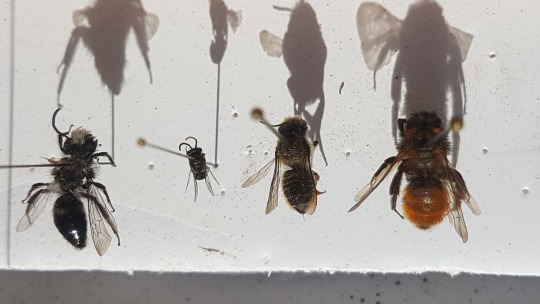



Here we have some pretty common Bees from 3 different families.
From left to right we have:
Andrena cineraria (male)
Hylaeus hyalinatus (male)
Megachile centuncularis (female)
Andrena fulva (female)
Okay so the A. cineraria is crushed but I found him. Finders keepers. Theyre a fairly common bee and nest in the ground although theyre solitary they tend to nest in the same area so youll see lots together. Even though they appear black they do have a lovely blue sheen, and are one of Als favorites.
The H. hyalinatus is another lovely bee. This striking yellow faced bee is just so tiny! He comes in under 5mm and arent really that fussy about where they nest it seems (thats what I think he is Hylaeus at least!)
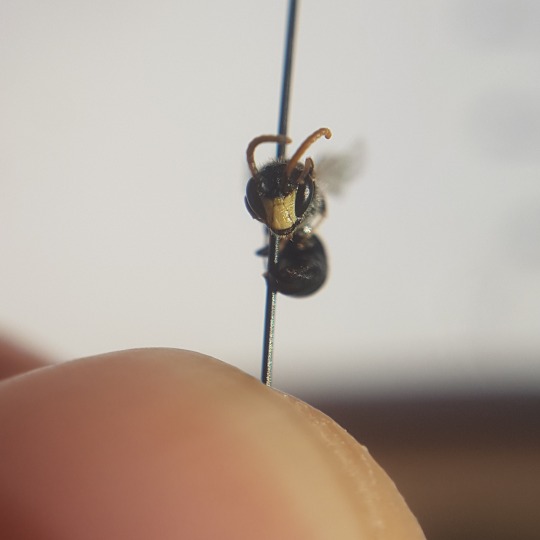
The next is a Leafcutter. Fascinating little bees who make their nests in holes packed with... you guessed it leaves! They cut out little circles of leaves and fly off with them which is fun to watch. Even if you dont see the bees themselves youll see the impact on the leaves. Another interesting thing about Leafcutters is that the females have a pollen brush on the underside of the abdomen rather than on the legs! Thats what that vibrant orange fuzz is underneath.
A. fulva also known as the Tawny mining bee is a very common bee and is really easy to identify. The males however are slightly more complicated the males of many Andrena species of hard to tell apart and often require a hand lense to seperate. This particular bee is seperated by looking at the length of a section of antennae so good luck with that.
Theres much more to look at so stick around.
19/04/20
#vulture culture uk#vulture culture#taxidermy#bones#skull#skull collecting#animal skull#pinned insects#curiosities#oddities
17 notes
·
View notes
Text
5 Garden Pests – Insect Identification & Treatment Tips
Prevent your garden from being devoured by uninvited pests. By knowing how to protect your garden from a variety of insects, you can grow your plants and crops stress-free.
gardeninginfo-online.com gathered the following information and tips to help you eliminate garden pests naturally, without using harsh chemicals.
Garden Pests – Identify and Combat These Insects
The following common garden pests, if left unchecked, can consume enough of your garden to leave your plants in poor health and your crops partially destroyed.
Slugs and Snails
Basically, slugs are snails without the shell. These gastropods eat large, ragged holes in the foliage of plants and can entirely consume seedlings. Slugs and snails pose a particular threat to:
Violets
Lilies
Cabbage
Lettuce
Strawberries
Spider Flowers (Cleome)
Floss Flower (Ageratum)
Hostas
The more problematic species of slugs and snails include:
Garden Snail (Helix aspersa)
Grey Garden Slug (Deroceras reticulatum)
Tawny Garden Slug/Cellar Slug (Limax flavus)
Leopard Slug (Limax maximus)
Slugs and snails travel over a trail of mucus, seek protection from dehydration in cool, shaded, and damp locations. Unless disturbed or treated, they will return to their hiding and feeding places nightly.
You can confirm the presence of snails and slugs in your garden by the dried mucus/slime trails they leave behind.
Control measures include:
Physical removal, when combined with other control measures, is an effective and long-lasting method of control.
Diatomaceous earth or “DE” sticks to the snail or slug’s body, causing desiccation. DE dust should be applied in inch-wide bands near and around your plants and garden. Reapplication may be necessary after heavy rain.
Copper strips fastened to flower bed containers or boxes are incredibly effective. Snails and slugs have a shock-like reaction when they are in contact with the metal.
Commercial traps, boards, tiles, shingles, or anything that offers daytime protection are very effective in trapping this pest.
Yeast trapping is another efficient method of control. Shallow containers filled with water and yeast or beer lure snails and slugs to the container only to fall into the liquid and drown.
While there are chemical control methods, it is highly recommended to seek natural, chemical-free solutions. If chemical control is used, pay particular attention to the label and its safety measures.
Caterpillars
Caterpillars are moths and butterflies in their larvae stage. These insects chew irregular holes in leaves or flowers and can entirely consume seedlings, young shoots, buds, leaves, or flowers.
A caterpillar’s diet is comprised almost exclusively of plants. Most caterpillars can be found consuming plant foliage, but some may feed on seeds, roots, stems, fruit, or flower petals.
Tip: Caterpillars can be identified by the three pairs of (true) legs behind the head and five or fewer pairs of leg-like appendages on some but not all abdomen segments. These features distinguish them from beetle, fly, and sawfly larvae.
Some of the more common, problematic species include:
Tent Caterpillar (Malacosoma americanum)
Evergreen Bagworm Caterpillar (Thyridopteryx ephemeraeformis)
Banded Woollybear Caterpillar (Pyrrharctia isabella)
American Lady Butterfly (Vanessa virginiensis)
Common Buckeye Butterfly (Junonia coenia)
Giant Leopard Moth Caterpillar (Hypercompe scribonia)
Bent-line Gray Caterpillar (Iridopsis larvaria)
Fruit Tree Leafroller Caterpillar (Archips argyrospila)
Cabbage Looper Caterpillar (Trichoplusia ni)
You can easily confirm the presence of caterpillars by examining the extensive damage to foliage, leading you to the insect’s presence. Caterpillars feed practically non-stop until they enter the pupa stage of their lifecycle.
Control measures include:
Pruning off rolled or webbed leaves and handpicking caterpillars from plants.
Applying bacillus thuringiensis-kurstaki (Btk) an organic microbial insecticide that kills only caterpillars. This product is safe to use around bees, beneficial insects, and wildlife. Newly hatched caterpillars must feed on treated leaves to be eliminated. Treatment timing is critical in early to mid-spring.
Covering your plants or crops with an insect barrier fabric (floating row cover). The covering forms a barrier, keeping moths and butterflies from laying eggs on the plants.
Neem oil can be sprayed directly on plants and foliage throughout late winter and spring to prevent egg laying and deter caterpillars from consuming the plant.
If commercial pesticides are used, pay close attention to the label and use only as directed. When treating edible plants, it is highly recommended to use organic alternatives.
Tip: When physically removing caterpillars from your garden, keep a container with a warm water and detergent solution handy. This solution kills caterpillars quickly.
Beetles
The beetle family (Coleoptera) consists of thousands of species, both destructive and beneficial, all necessary to maintain equilibrium in our environment. The following beetles are considered beneficial in a garden setting:
Tiger Beetles (Cicindelinae)
Soldier Beetles (Cantharidae)
Lady Beetles (Coccinellidae) also called ladybirds and ladybugs
Lady Beetle Larvae
These beetles spend their larval stage and adulthood consuming aphids, mealybugs, small invertebrates, and other insects. The following beetles devour plants, leaves, flowers, and can severely damage or kill trees:
Japanese Beetles (Popillia japonica)
Black Blister Beetles (Epicauta pensylvanica) Meloidae family
Red Milkweed Beetles (Tetraopes tetrophthalmus)
Cottonwood Borer (Plectrodera scalator)
Northeastern Sawyer Beetle (Monochamus notatus)
Rose Chafer (Macrodactylus subspinosus)
All beetles have a set of hard outer wing cases, known as elytra, and a hard upper body called a carapace. The elytra cover the flight wings and come together to form a straight line down the back. Beetles all have chewing mouthparts, powerful jaws, and antennae that are often longer than their boy length.
Damages may include boring holes in stalks and trunks, and partially or entirely consumed foliage, flowers, or fruit.
Control measures include:
Apply floating row covers
Prune and destroy (burn) affected stems and foliage
Handpick them and drown in a warm water, vinegar, and detergent solution
Spray foliage and stems with insecticidal soap or neem oil
Set out lures to draw soldier beetles (predators) to your yard and garden
Tip: You can attract soldier beetles by cultivating pollen-producing plants and allowing milkweed and wild lettuce weed species to grow.
Note: Using commercially produced chemical sprays or deterrents may cause severe damage to beneficial insects and the plant itself. It is highly recommended to use organic alternatives when treating consumable crops.
Aphids
Tiny aphids (Aphidoidea) congregate and quickly reproduce to form large groups that wound and suck juices from the host plant to the point of causing it to wilt, dehydrate, die. Without control measures, a small aphid issue can become an out-of-control infestation.
Aphids have long antennae and two tubes projecting from the rear of their abdomen. They are found in green, yellow, red, brown, or gray. They may be winged, depending on the species and life stage.
They usually congregate on fruits and vegetables, flowers, ornamentals, and even shade trees throughout the North American continent. Aphids feeding on plant sap cause foliage to distort and drop. Honeydew excreted on leaves promotes sooty mold growth, and their feeding can spread viral plant diseases.
The honeydew produced by aphids not only causes the growth of sooty mold, but it also attracts other insects, including ants, that compound the pest problem.
Control measures include:
In infested areas, frequently wash sturdy plants with a strong spray of water
Attract native predators and parasites such as aphid midges, lacewings, and lady beetles
Cover plants with floating row covers
Apply hot-pepper, garlic repellent sprays
When infestations become severe problems, apply horticultural oil, insecticidal soap, or neem oil
Note: Aphid infestations are typically accompanied by an ant infestation. Ants “herd” the aphids and farm the honeydew to nourish their colony. Once you control the aphid infestation, direct your attention to controlling the ants.
Ants
Individual ants are members of highly organized colonies. They are always in search of nourishment and water to promote the health and growth of their colony.
Once a source of nourishment is located, ants will return to their colony via a pheromone trail, which is the path for the rest of the colony to follow. As long as the pheromone trail exists, ants will follow it regardless of your control measures.
Ant colonies can consume incredible amounts of plant foliage, but, as previously mentioned, they can also “herd” aphids to collect the honeydew they produce after consuming the juices from your plants.
Some of the more destructive ant species are:
Black Garden Ant (Lasius niger)
Black Carpenter Ant (Camponotus pennsylvanicus)
Fire Ants (Solenopsis invicta) also known as Red Imported Fire Ant (RIFA)
Wood Ants, Mound Ants, Thatching Ants, and Field Ants are all part of the genus Formica
Leafcutter Ants are part of nearly fifty species belonging to the Atta and Acromyrmex genera
Control measures include:
Squeeze a lemon or an orange over areas where the ants transit
Sprinkle pepper, salt, cayenne pepper, or cinnamon around areas you wish to protect
Peppermint or white vinegar can be spread around to repel them
Spray ants with a mixture of water and dish soap (the soap penetrates their exoskeleton and kills them)
Lay a one-inch strip of food-grade diatomaceous earth by trails and nests
Set borax (or boric acid) and sugar poison traps around your plants
Set traps with powdered sugar and baking soda (the baking soda dries their bodies and kills them)
Eliminate aphids from your garden
Tip: Wherever you see an ant trail, make it your goal to interrupt the pheromone trail they are leaving behind. You can accomplish this with diluted white vinegar or juice squeezed from a lemon or an orange.
Note: When you apply salt to soil, you are altering the soil’s pH and potentially harming the plants growing there.
Read the following link for additional tips and advice on keeping pests out your garden, and check out this simple recipe for homemade non-toxic pesticides for your garden.
Garden Pest Control
In this article, you discovered information on how to identify and eliminate 5 destructive garden pests without using harsh chemicals.
When you take action to control and eliminate garden pests, you can preserve your garden and crops, harvesting pristine fruits and vegetables.
Allowing garden pests to flourish can lead to massive infestations leaving your garden looking chewed up and dying.
Sources:
extension.umd.edu/hgic/topics/slugs-and-snails-flowers
wildlifetrusts.org/wildlife/how-identify/identify-caterpillars
insectidentification.org/insect-description.asp?identification=Aphids
extension.umn.edu/insects-infest-homes/ants
caterpillaridentification.org/
ipm.ucanr.edu/QT/lfcaterpillarscard.html
The post 5 Garden Pests – Insect Identification & Treatment Tips appeared first on http://gardeninginfo-online.com.
1 note
·
View note
Text
Animal practice 38
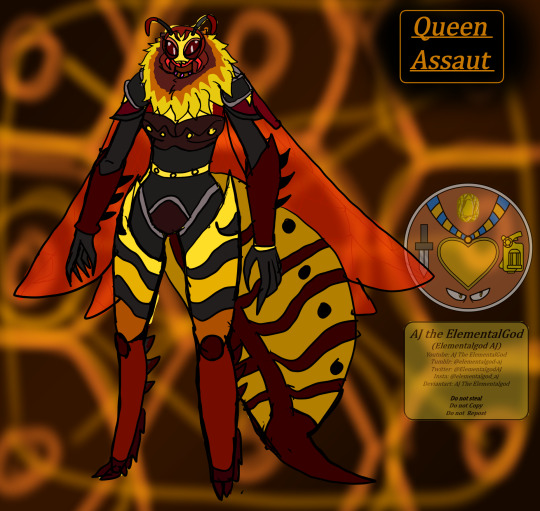
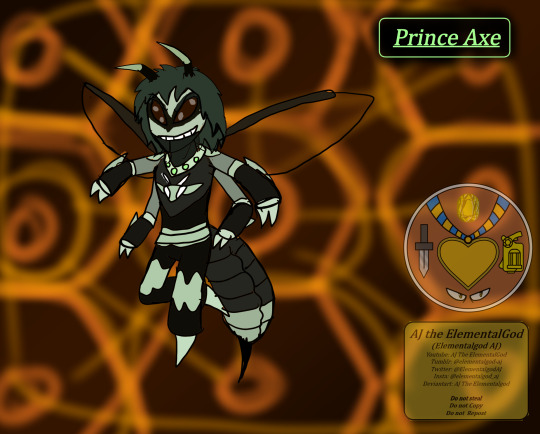


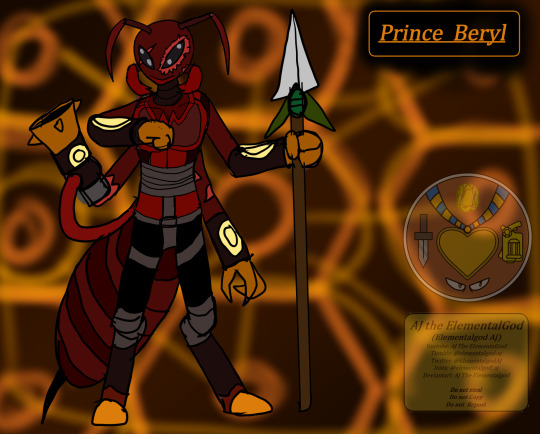



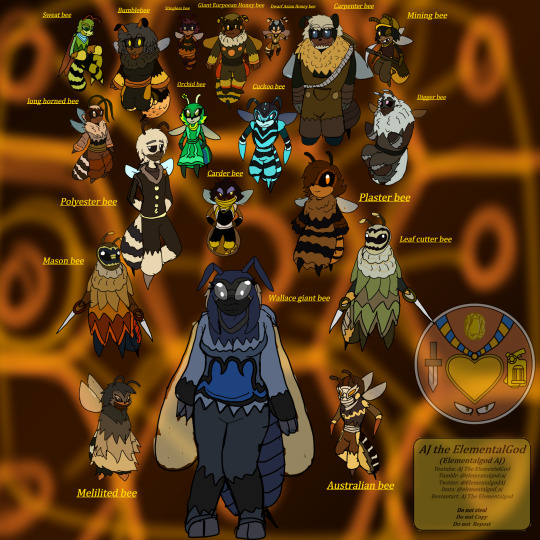
Panarthropoda
Arthropoda 4
Hexapod 5
Hymenoptera 2
Vespidae
Queen Assaut
Prince Ax
Giant Hornet
Executioner wasp
Yellow jacket
European wasp
Potter wasp
Warrior wasp
Hover wasp
Pollen wasp
Formicidae
Queen Amber
King Ore
Prince Beryl
Black Ant, Red Ant
Argentine Ant, Erratic Ant, Stink Ant, Cone Ant
Eciton Ant, Driver Ant
Bulldog Ant, Dinosaur Ant
Carpenter Ant, Amazon Ant, Crazy Ant, Honey pot Ant, Tree Ant, Giant Forest Ant
Harvester Ant, Pharaoh Ant, Black Ant, Electric Ant, Leaf cutter Ant, Pirate Ant, Lemon Ant, Raider Ant, Weaver Ant
Anthophila
Queen Apidae
Prince Kyle
Ming bee
Digger bee, Long horned bee
Honey bee (dwarf bee, giant bee, Asian bee, European bee, Killer bee), Bumblebee, Orchid bee, stingless bee, cuckoo bee, carpenter bee
Plaster bee, Polyester bee
Sweat bee
Mason bee, leafcutter bee, carder bee, Wallace's giant bee
Melitted bee
Australian bee
#the watchful eye#watchful eye#my oc#my ocs#my art#elementalgod aj#aj the elementalgod#isle 0#toonverse oc#o'kong family#neo demons#anthro allies#earthdemons#panarthropoda#arthropods#hexapods#insects#hymenoptera#bees#ants#wasps#vespidae#formicidae#anthophila
5 notes
·
View notes